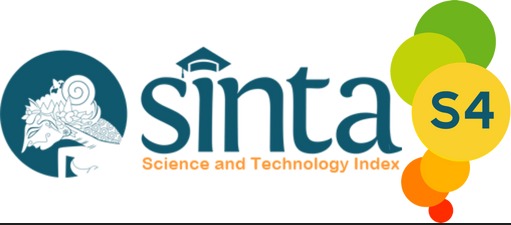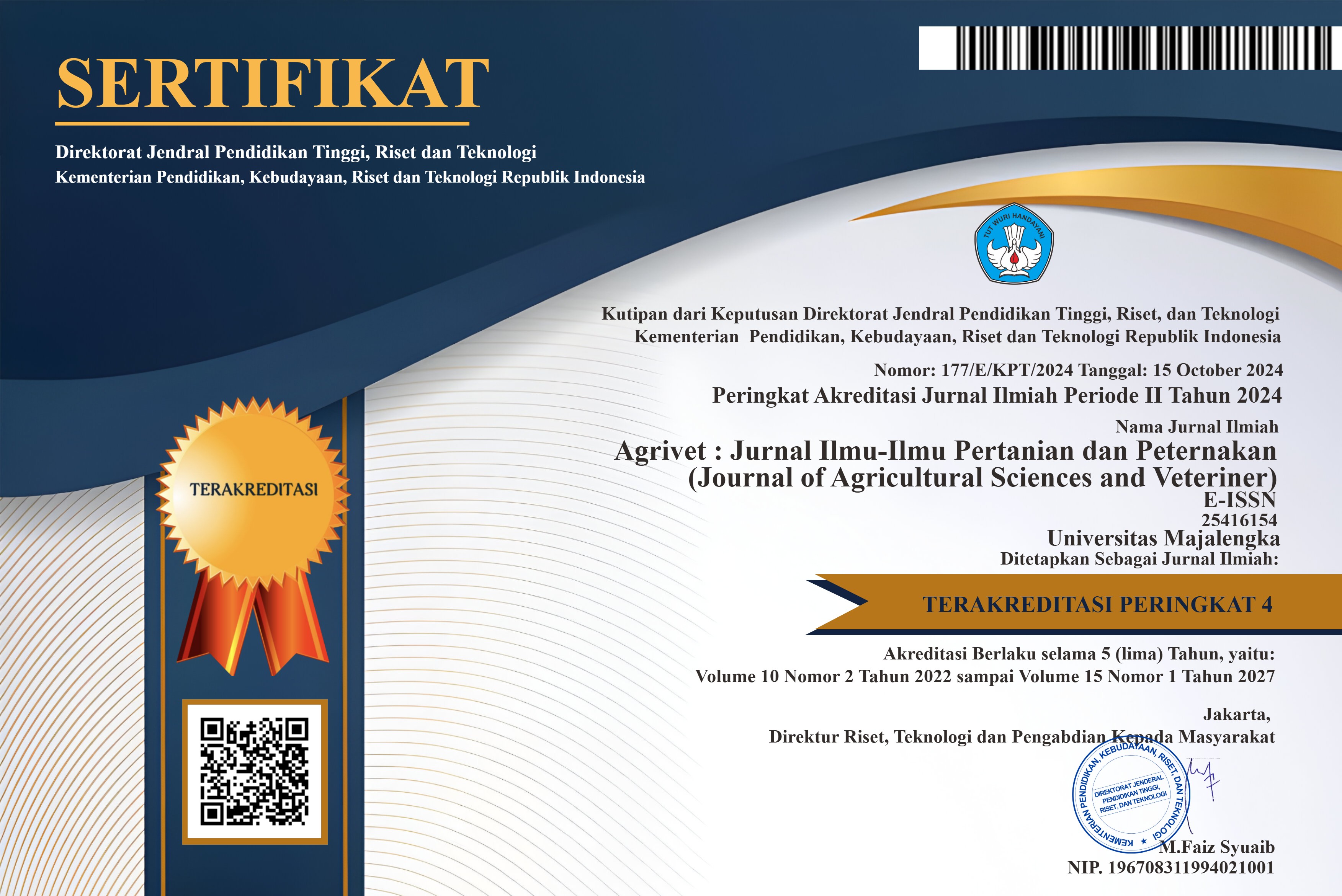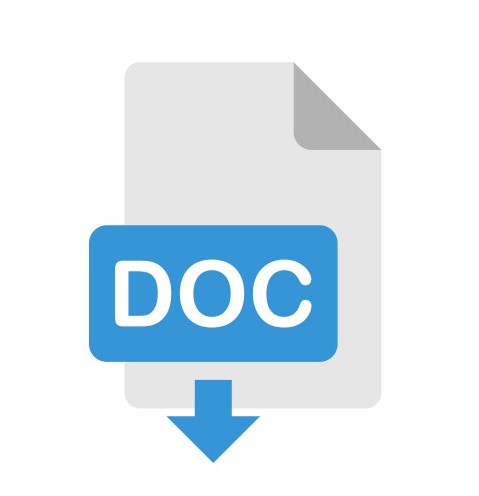Respon Pemberian Liquid Organic Biofertilizer Urin Kambing Terhadap Pertumbuhan Dan Hasil Kedelai (Glycine max L.)
DOI:
https://doi.org/10.31949/agrivet.v10i2.4103Abstract
Soybean (Glycine max L.) is one of the main food commodities after rice and corn. The need for soybeans in Indonesia is quite high. Soybeans are used as a basic ingredient for various processed foods such as tempeh, tofu, soy milk, tauco, snacks, and the soy sauce industry. Apart from being a food ingredient, soybeans are also used as industrial ingredients and animal feed. The high level of population consumption in Indonesia for soybeans and their processed products makes soybeans an ingredient sought by the community, therefore it is necessary to increase soybean productivity to meet domestic needs. One way to increase production while reducing inorganic fertilizers is the use of Liquid Organic Biofertilizer (LOB). This study aims to determine the effect of LOB on soybean growth and yield. This study used a non-factorial randomized block design (RBD) with six treatments with four replications. The treatments tested were: P0 = Without LOB, P1 = Concentration of 25 ml/l of water, P2 = Concentration of LOB 50 ml/l of water, P3 = Concentration of LOB 75 m/l of water, and P4 = Concentration of LOB 100 ml/l water, P5 = LOB concentration 125 ml/l water. The results showed that the application of Liquid Organic Biofertilizer of golden snails had a significant effect on plant height and number of leaves 2 weeks, 4 weeks and 6 weeks, while the number of branches and the number of root nodules was effective at 6 weeks.
Keywords:
Soybean Plants, Liquid Organic Biofertilizer, Goat Urine.Downloads
References
A. Kalay, R. Hindersah IN et al. 2021. Pemanfaatan pupuk hayati dan bahan organik terhadap pertumbuhan dan hasil tanaman jagung manis (. (21):129–138.
Akhsan F, Sukriandi, Amris AFK, Irmansyah M. 2021. Pengaruh Pupuk Organik Cair dengan Konsentrasi Urin dan MOL Berbeda terhadap Produksi Rumput Gajah Mini (Pennisetum purpureum cv. Mott). J Sains dan Teknol Peternak. 2(1):13–18. https://doi.org/10.31605/jstp.v2i1.815
Astuti K, Prasetyo OR, Khasanah IN. 2020. Analisis Produktivitas Jagung dan Kedelai di Indonesia 2020 (Hasil Survei Ubinan). [place unknown].
Fauzi AR, Puspitawati MD. 2018. BUDIDAYA TANAMAN KEDELAI ( Glycine max L.) VARIETAS BURANGRANG PADA LAHAN KERING. J Bioind. 1(1). https://doi.org/10.31326/jbio.v1i1.89
Ir. Dyah Riniarsi Triyanti MS. 2020. Komoditas Pertanian Tanaman Pangan Kedelai.
Isnaini JL, Syatrawati, Yusuf M, Piandi. 2022. PERBANDINGAN PENGGUNAAN PUPUK CAIR URIN KAMBING DENGAN PUPUK NPK MAJEMUK TERHADAP PRODUKSI TANAMAN KAKAO (Theobroma cacao. L). 1(1):22–28.
MeirinaTettrinica, Darmanti S, Haryanti S. 2012. PRODUKTIVITAS KEDELAI (Glycine max (L.) Merril var. Lokon) YANG DIPERLAKUKAN DENGAN PUPUK ORGANIK CAIR LENGKAP PADA DOSIS DAN WAKTU PEMUPUKAN YANG BERBEDA. Bul Anat Dan Fisiol. 17(2).
Rohmah EA, Saputro B, Biologi J, Matematika F, Alam P, Teknologi I, Nopember S. 2016. Analisis Pertumbuhan Tanaman Kedelai ( Glycine max L . ) Varietas Grobogan Pada Kondisi Cekaman Genangan. 5(2).
Sarah, Rahmatan H, Supriatno. 2016. Pengaruh Pemberian Berbagai Konsentrasi Urin Kambing yang Difermentasi terhadap Pertumbuhan Vegetatif Lada (Piper nigrum L.). J Ilm Mhs Pendidik Biol. 1(1):1–9.
Sitepu N. 2019. Pengaruh Pemberian Pupuk Cair Urin Kambing Etawa terhadap Pertumbuhan Bawang Merah. BIOEDUSAINS J Pendidik Biol dan Sains. 2(1):40–49. https://doi.org/10.31539/bioedusains.v2i1.616
Wahyudin A, Wicaksono FY, Irwan AW, Ruminta R, Fitriani R. 2017. Respons tanaman kedelai (Glycine max) varietas Wilis akibat pemberian berbagai dosis pupuk N, P, K, dan pupuk guano pada tanah Inceptisol Jatinangor. Kultivasi. 16(2):333–339. https://doi.org/10.24198/kltv.v16i2.13223
Published
How to Cite
Issue
Section
License
Copyright (c) 2022 Acep Atma Wijaya, Nugraha Dadan Ramdani

This work is licensed under a Creative Commons Attribution-ShareAlike 4.0 International License.
An author who publishes in the Jurnal Agrivet agrees to the following terms:
- Author retains the copyright and grants the journal the right of first publication of the work simultaneously licensed under the Creative Commons Attribution-ShareAlike 4.0 License that allows others to share the work with an acknowledgment of the work's authorship and initial publication in this journal
- The author is able to enter into separate, additional contractual arrangements for the non-exclusive distribution of the journal's published version of the work (e.g., post it to an institutional repository or publish it in a book) with the acknowledgment of its initial publication in this journal.
- The author is permitted and encouraged to post his/her work online (e.g., in institutional repositories or on their website) prior to and during the submission process, as it can lead to productive exchanges, as well as earlier and greater citation of the published work









